The Friends' School Year 7 Walker

Hello hello Friends Grade 7s!
Thank you for your questions about climate change. You asked some really interesting questions about animals, impacts on our earth, future of our Earth, and taking action. We especially liked all your videos!
You'll find answers to your questions from our climate experts below - have a read and watch their answers.
You can also have a look at what other classes across Tasmania asked this year, as well as our climate change toolkit.
Our Questions
Could the Earth ever enter another ice age? The short answer is quite probably, but maybe not for a very long time. However, nothing is certain, especially with the current human-induced changes now occurring. To explain why the answer is probably, we can look at what we know about past climate.
The Earth’s climate has varied over millions of years (see Figure 1). You can see that it was very warm around 56 millions years ago, and very cold around 25,000 years ago. The temperature has generally increased since about 20,000 years ago. But you can also see that there are a lot of ‘little’ ups and downs’. If you look at Figure 2, this shows variations over the last 800,000 years. The line in the middle is temperature. You can see that there are semi-regular periods of colder temperatures (glacial periods, or what some people call ice ages) that last for tens of thousands of years. The warmer (inter-glacials) and colder periods (glacials) can be related to a number of factors that affect Earth’s climate from ‘outside’ the Earth. We call these external forcings.
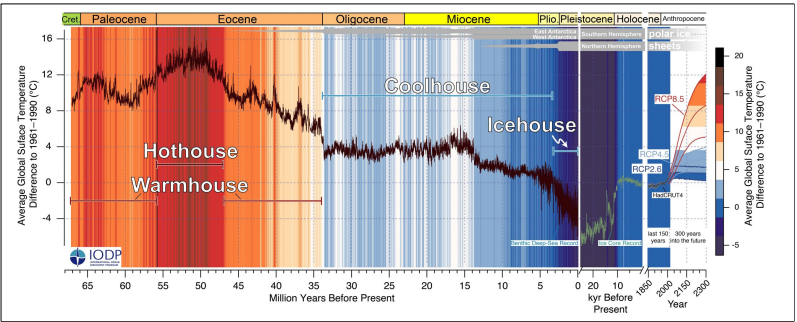
Source of Figure: Westerhold et al. 2020 Science
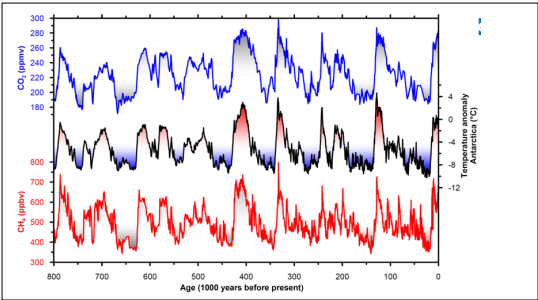
One of the important external forcings of glacial and interglacial periods is related to how earth travels around the sun. About 100 years ago, a smart guy from Serbia called Milutin Milankovic realised that there were three important ways the Earth’s orbit around the sun changed over long time periods. We can call these, stretch, wobble and roll (see Figure 3). These have periods (or cycles) of thousands of years. If you look at Figure 2 again, you can see that warm temperature periods occur around once every 100,000 years (give or take). This is very similar to the period of how Earth’s journey around the sun changes over time (stretch). So, around every 100,000 years, our orbit becomes more ‘circular’ or ‘less elliptical’, so we are closer to the sun. When our orbit becomes more elliptical, we are further away from the sun for much of the time, and our climate is cooler. The other two cycles are also important, but less relevant to your question. They will have important impacts on seasonal differences in the hemispheres and day lengths from the equator to the poles. In Figure 4, there’s a plot of the cycles over time, and down the bottom is a plot of stages of glacial and interglacial periods.
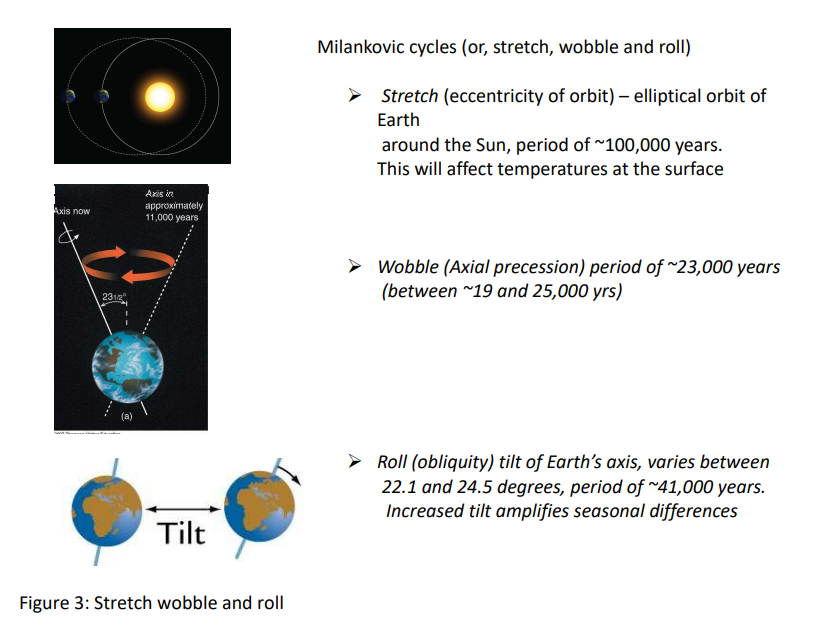
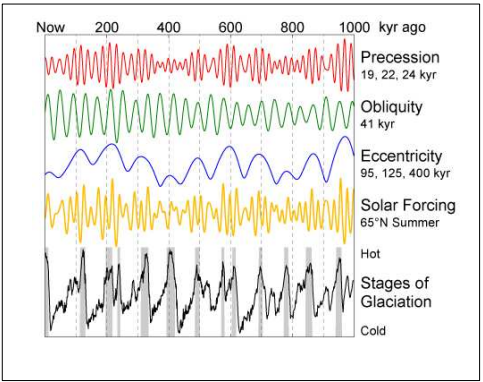
There are also other factors that affect the Earth’s climate that come from ‘outside’ the Earth (we can call these external forcings). You have probably heard of sunspots. There have been periods when there are less sunspots (the sun is cooler). When the sun is cooler, the Earth is cooler, too. These also have an impact on Earth’s climate, but on much shorter time scales (generally decades).
So, the longer answer to your question is that there are some factors that affect Earth’s climate that come from outside. These have big impacts on our climate and can ‘set up’ positive feedback loops meaning that when one thing happens it leads to another process which then causes some thing else. Like dominoes falling over. Or maybe like when you get up in the morning feeling a bit grumpy and say something not so nice to your brother or sister. They’re then nasty back to you and you get grumpier. When you go to school you’re still grumpy and take it out on your friends who then get grumpy with you. This would be positive feedback because one bad thing leads to another bad thing (or if you got up happy and said nice things…etc. That would also be positive feedback).
It is hard to know what will happen in the future with man-made climate change which is warming our planet very quickly. If we continue release CO2 as we are at present, we are unlikely to experience another ice age any time soon. Our orbit of the sun is currently quite ‘circular’ (or least elliptic) but is slowly becoming more eccentric. So, it is reasonably likely that some time in a little less than 100,000 years the Earth may enter another glacial period.
What it will look like then is another matter altogether.
There have been quite a few questions asking which countries and which places in the world are most affected by climate change, and about which countries are getting hotter, quicker.
As you know, the effects of climate change are different everywhere. Overall, we are seeing the planet heating, but this has different impacts in different places.
Did you know that climate change is also affecting where rain falls? How windy it is? When and where cyclones occur? There is nowhere on Earth that climate change isn’t having an impact, but the ways that climate change affects different countries depends on lots of different factors, including their geographical location, their exposure to different types of change, the sensitivity of the environment to change, and the capacity of their human population to adapt.
Understanding which is the most affected country depends on the risk criteria you are looking at.
If you wanted to know where the highest number of people are affected by climate change right now, you might think of countries affected by more intense extreme weather events, like Pakistan, Haiti, and the Philippines.
Also greatly impacted are countries with large cities in south-east Asia like Indonesia, and Bangladesh, which are losing coastal land with sea level rise, or countries in Africa affected by drought, like Kenya. If you wanted to know which countries are being faced with becoming unliveable or being lost altogether, you might think of countries in the Middle East reaching 50°C more often, or low-lying islands like Tuvalu, the Torres Strait Islands, and the Maldives.
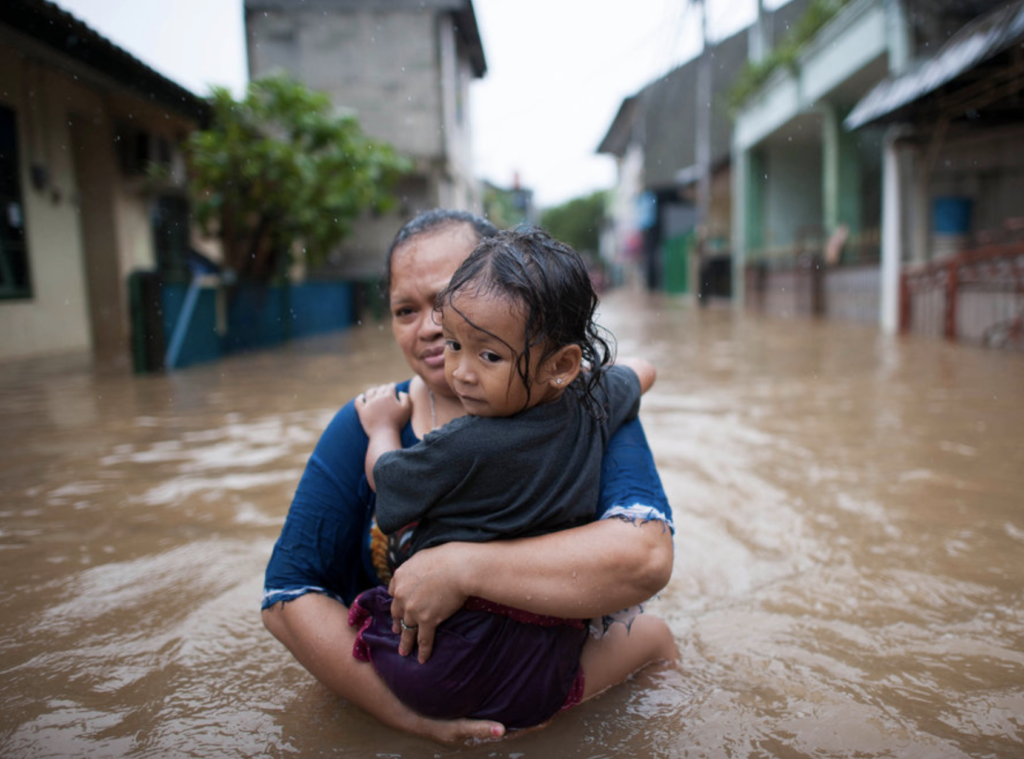
In Bangladesh, salt water flooding over land has made farming impossible in many areas and finding fresh drinking water challenging.
In other parts of the world, the effects of climate change will be most felt by millions of people in terms of access to water. Many countries rely on water from glacier and snow melt both for drinking water and for agriculture. Countries like the Andean nations especially Peru, Chile, Bolivia, and countries in Southeast Asia that rely on glacier meltwater from the Himalayas could be strongly affected, as glacier ice is now melting faster than ever and less snow is tending to fall in some places – meaning there will be less water available in the long term.
Of course, parts of the planet that are already hot will become much more difficult to live in as it becomes hotter. Tropical areas around the Equator are most at risk here. Tropical areas could be pushed towards the limits of what humans can survive if temperatures rise more than 1.5°C above preindustrial levels. Humans can tolerate dry heat better than they can humid heat. Humans are unable to tolerate what is called a “wet bulb temperature” (that’s a measure of heat and humidity together) of over 35°C for very long. In these conditions, the human body is not able to cool itself down by sweating and such conditions can be fatal. Such conditions may have dire consequences for many animals as well. With temperatures increasing everywhere, this could have very serious consequences as about 40% of the world’s population currently lives in tropical areas. This effect of climate change alone could cause a huge refugee crisis with potentially millions of people displaced by climate change by 2050.
Just in terms of temperature rise, perhaps surprisingly, some of the coldest areas have warmed the most due to climate change. Though the global average temperature rise is currently at 1.1°C above preindustrial levels (and Australia’s average temperate is currently 1.44°C higher than when records began) the Arctic is heating up much more dramatically. Between 1971 and 2019, the Arctic’s average annual temperature rose by 3.1°C, meaning it’s heating almost three times faster than the rest of the planet – with drastic consequences on Arctic ecosystems and Indigenous peoples who call the Arctic home. The following video can help us to visualise which parts of the world have heated up most over the past 140 years, and therefore helps us understand which areas are currently most affected by climate change
While some countries might be worse off than others, and some countries might have more capacity to do something to limit the impacts, climate change is affecting ALL OF US and we all have a responsibility to make a positive difference.
Stopping, or reducing climate change, known as mitigation, is something that is really important so I’m very glad you’ve asked how to do this.
Reducing climate change will involve lowering the level of greenhouse gases in the atmosphere. This means reducing the emission of heat-trapping greenhouse gases. This is done by reducing the use of fossil fuels and moving to renewable energy sources, like wind, solar and ocean wave energy instead. The effectiveness of these energy sources is improving all the time and around the world (especially in Australia) they are becoming a major source of energy already. Increasing efficiency and finding ways of reducing energy use and waste is also very important. Around the world businesses and governments are making commitments to reduce the use of fossil fuels and to transform manufacturing, food production and transport (e.g. trucks, cars, trains and shipping) to electricity or other fuels (like hydrogen).
Another way to help mitigate climate change is to support processes that actively remove carbon out of the atmosphere. Healthy oceans, forests and soil are great carbon stores. This means restoring and protecting these environments and supporting sustainable practices will help. Growing trees is a great way of helping remove carbon from the atmosphere. This effect is so large that the natural regrowth of Tasmania’s forests means that the state is currently a carbon sink – meaning more carbon is removed from the atmosphere than is emitted. This means as a state Tasmania is doing better than the net zero emissions target governments around the world are talking about.
Rather than just letting the trees do all the heavily lifting though we can help Australia and the world by reducing our individual emissions. On a personal level that means turning lights and appliances off when you’re not using them; putting on a jumper rather than turning the heating up to full; and walking, cycling, or using public transport if we can. Also finding out about what you eat and changing to options that contribute less to climate change can also help. Agriculture is a major producer of greenhouse gases so look for low carbon meals, such as sustainable seafood and local seasonal foods, and try having at least a couple of red meat free days a week.
In addition to reducing energy use we can also consume less (e.g. use clothes for longer rather than chasing the latest fashion look), increase recycling and appropriately dispose of organic waste (e.g. food scraps). Methane is a powerful greenhouse gas, over twenty years it is about 80 times more potent at warming than carbon dioxide. When food and garden waste is buried with general garbage the microbes and chemical processes that break the waste down cannot easily access oxygen and so they produce a lot of methane (known as anaerobic breakdown). However, if you put the organic waste into a compost bin (at home or one provided by the council) the microbes can access oxygen and so they use a process that produces much less methane (known as aerobic breakdown). The nutrient rich compost that results also means more plants can be grown (absorbing carbon) and less energy is needed to make artificial fertiliser. A win-win-win.
The biggest thing you can do to help climate change is to stay informed, to help share useful information and to think about your actions – each little bit really does help. Around the world innovations and action by young people is helping accelerate action to reduce climate change.
For starters, you might like to find out how Tasmania’s tree growth is helping our carbon budget. NASA also has a great page on climate change, which mentions some solutions. The United Nations also has some high-level information on different activities around the world.
You might also like to play with the simple climate model at en-Roads, explore options for reducing climate change
What will happen to animals? The answer is- it depends. Some will move around to find new places to live. Some will evolve to the new climate conditions where they currently live. And some species will die or go extinct. Let’s look at how species might respond and why this means that even with evolution and moving, some will still die.
Species are evolving and moving in response to climate change. Examples of evolution are changes in how a species can tolerate extreme temperatures – known as thermal ranges. Some species will die at particular temperatures. For example in late 2018 many flying foxes died in an extreme heat wave in northern Australia. Marine heatwaves result in mass coral reef deaths.

But if individual plants or animals within a species happen to have or abilities to survive at higher temperatures, then, over time, those traits will become widespread within the species, because those individuals survive and reproduce. In fact, scientists are selectively breeding coral reefs for their ability to tolerate higher temperatures and then farming these corals to improve the health of the Great Barrier Reef.
Some species can also move around in order to follow suitable climate conditions (like the right temperature or rainfall for them). Plants use wind to move seeds kilometres away, birds can fly long distances to find the next suitable tree hollow to live in, and mammals can follow habitat corridors like rivers and tree lined fences to find the next forest to live in. In this way, some species can continue to adapt and follow changes in their habitat to survive. Scientists call this ‘species on the move’ and it’s a big area of current research. These scientists estimate that so many species will move or redistribute themselves, the types of plants and animals you see out your back door today may well be different in the future.
But evolving, or moving, takes time. Evolution is a multi-generational process. And species tend to move anywhere from a few metres to 10s of kilometres each year depending on how big and how mobile they are. If climate change outpaces the speed at which species can move or change, then they are at risk of dying.
One study estimated that if we follow our current, business-as-usual trajectory of climate change, which is projected to lead to a 4.3°C temperature rise, climate change would threaten one in six species (16%). This could as much as double our extinction rates.
The species that are most likely to be at risk of extinction are those that are on islands (like New Zealand and Australia) where there’s not enough space for species to move or track their preferred climate. So here in Australia, we will have more species extinctions due to climate change relative to other parts of the world.
This is one of many reasons why people are calling for governments to limit climate change to 1.5°C, by ‘decarbonising’ our economy – or stopping emissions of CO2. If we do this, we can reduce the rates at which plants and animals become extinct.
Climate change and its causes will affect your generation in many different ways, in Australia and elsewhere. These include rising average temperatures, more frequent and severe storms, floods and bushfires, and extinction of plants and animals. The loss of topsoil from drought, flood and wind and unpredictable weather will affect farming and could cause more frequent and severe famines. This could lead to increasing political tensions in some countries around access to resources. People and governments will need to spend more money on safety and preparedness. These impacts are all related to one another.

A lot of produce will become more expensive as environments change. This includes coffee and honey, and even some vegetables, fruits and meat. Campfires, burn-offs and open-flame barbeques would be restricted for longer parts of the year as fire bans become increasingly common. Take the example of the 2020 bushfires. More than 3 billion animals were impacted, forests were damaged or destroyed, and human tragedies included loss of life, health, homes and livelihoods. Crises like this would be repeated in increasingly worse fire seasons, meaning bigger and bigger expenses for fire preparedness. Taking action on climate change will not stop these impacts entirely, but it can reduce them.
Climate change and its causes impact more than the natural environment. They have knock-on impacts in health. Air, water and soil pollution will continue to cause health conditions and worsen existing ones like cardiovascular and respiratory diseases as well as cancers. While these outcomes are less common in Australia, they happen here too. People in poorer communities with fewer support structures are impacted most. Your generation will see these impacts in your lifetimes. In fact, you already have. Increased exposure to new infectious diseases in the environment has also been linked with climate change, meaning epidemics and pandemics may be a thing of the future and not just the present.
While these impacts cannot be stopped completely, there is so much that can be done to avoid the worst of it. If we rapidly reduce the greenhouse gas we emit, we can improve the future for your generation and the generations who follow you. Action on climate change now will play an important part in your future quality of life, and in the lives of many others around the world in your lifetime.
We had a few questions about the future of our atmosphere! See Dr Stuart Corney's answer about what the atmosphere will be like in 100 years below.
This is such an important question to ask!! Often when we make positive changes in our own lives to lower our carbon footprint, or be more climate aware, we ask ourselves Is what I’m doing being reflected by my wider community? Or, Are the changes I am making being supported by decision makers?
First, when looking at the national government, the answer is unfortunately no. In the last decade, Australia’s government has been notably weak in its response to climate change. Internationally, other countries have found it difficult to work with Australia on climate change policy, and whilst Australia has made a lot of international promises on reducing carbon emissions, the actions needed to do this have not happened yet.
But – here is some better news - recent government changes in Australia show that significant positive change is possible. Communities are raising their voices and expressing their opinions on important issues – and this has real and tangible impacts. Community efforts can have a big influence on government priorities, which are strengthened when we all step up and engage with more. Sometimes it can feel like the government operates in contrast to society and what people actually want, especially in recent years. Government can seem like this distant power away from us all. But it is important to remember that government represents us and our values and priorities. We elect politicians to make decisions for us, we protest when we disagree with the direction of their policies, and we demand change when we see thing not going the way we want.
In the past few years, Australia has seen a meaningful shift on climate issues. For example, the bushfires and flooding we have seen over the past two years have made communities stand up, ask questions, and demand changes in the national government’s actions on climate. We’ve also seen more political engagement from young people – including the school strikes for climate. This has had a big influence on the wider climate conversation in Australia and had positive impacts in local communities, state governments and now the national government too. A lot of politicians who are determined to see climate action were elected in the recent federal election. And the new government has taken immediate action. After being elected, they quickly announced the Climate Bill 2022 and put strong carbon emissions reduction targets into law: a 43% cut by 2030 and a reduction to net zero by 2050.
Engaging in the political process has real impact – but it’s important to remember that this goes beyond just voting. Having conversations about climate within your family, friends, classmates, and communities is also key. You can have a say by emphasising why climate action is important to you and your future. You can join other young people in protesting for the changes you want to see, or by raising awareness about the concerns you have. By being the change you want to see - and putting in the effort to engage - your community and government will follow.
The most significant thing that we are doing that makes climate change worse is failing to reduce CO2 emissions. We could also do a better job of planning for the future. This would include building more energy efficient houses, taking account of climate change when we decide where to place new infrastructure, and focussing on renewable energy.
Planning for climate change is a large international challenge. The global community could work towards the goal of doing something about climate change if its attention was not distracted by wars, pandemics and economic crises.
But also, individual action is really important. In my own life, I focus on trying to live more sustainably, by riding my bike to work, installing solar in our house, composting, eating mostly vegetarian meals, driving less and owning a hybrid car (and one day an electric car).
Great question, one that a lot of experts are working on every day! While the answer to this question differs greatly between each of those different groups, a good place to start is break down climate goals into two main categories: mitigation and adaptation. Mitigations are the actions you take to reduce contributions to climate change while adaptations are the actions you take to be better prepared for the negative impacts caused by climate change. Even those these are typically separated when we write plans and policies, it is not either/or, but both at the same time. As for your school, a local business, or your wider community some of these actions are more achievable than others.
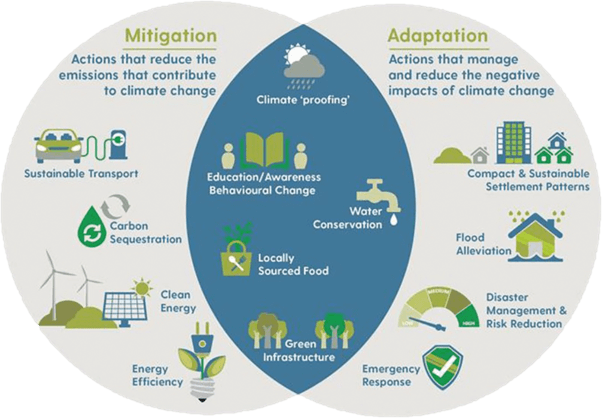
The most important thing you can do is to become informed, like by reading and watching all the answers on Curious Climate! Do you know how much water and electricity your school uses? Has your school considered adding solar panels or purchasing electric school buses? Do you know where the food in your cafeteria comes from or if your school is at risk of floods or bushfires? Knowing the answers to these questions is the first step in taking action to address climate change. Many businesses have already taken this step by identifying where they can and can’t take action to reduce their impact and if they are climate “proofed”, meaning are they prepared either physically or financially for extreme weather events.
For communities, like many of those across Tasmania and Australia, there have been plenty of efforts to research and write both climate change mitigation and climate change adaptation plans. The plans include actions like putting in more electric car charging stations, replacing lightbulbs with more energy efficient LEDs, creating climate change outreach programs, and developing vast disaster management plans so that you, your family, your school, and all the local businesses are prepared for floods, bushfires, and other disasters. The biggest challenge for communities is that there are not enough resources to cover every action they want to take. By working with your school to both mitigate and adapt to climate change, you can help alleviate their burden and help everyone to meet their climate goals.













